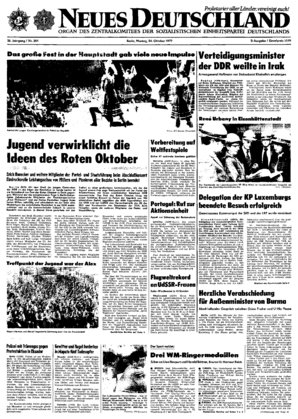Festival of ‘Red October’, East Berlin in 1977

Souvenir scarf from “Festival of Red October”, ‘Capital of the GDR, October 1977’; note the signatures, a popular way for attendees to personalize their souvenir (photo: Jo Zarth).
Today marks the 100th anniversary of the beginning of the “October Revolution” in Tsarist Russia, a date of particular importance on the East German calendar. As the Soviet Union’s most loyal ally, the GDR went to considerable lengths to demonstrate its fealty to the Communist cause and commemorating this event was a key part of that ritual.
On the 60th anniversary of “Red October” in 1977, the leaders of the German Democratic Republic, the revolution’s self-proclaimed German heirs, were not going to let occasion pass without giving it its proper. So from October 19-22, 1977, the country’s official youth organizations, the Free German Youth and Young Pioneers, held “The Festival of Red October” in East Berlin. The festival brought together tens of thousands of East German young people with 4,000 representatives of the Komsomol, the Soviet Union’s official youth organization, for for a full program of cultural events, showcases of their work and a review of past achievements.
The Party’s aim for this event were summed up by Erich Mielke, the notorious head of the Stasi, Erich Mielke, and the man ultimately responsible for making sure things went off without a hitch: “At this festival, the younger generation of the GDR will express their close ties to our Workers and Peasants State in a variety of ways.” (http://www.berliner-zeitung.de/16717396 ©2017)
- “November 7, 1917: Beginning of a new Epoch”: “Their program lives on in our actions”: Agitprop poster from a booklet produced in 1989 for “Agitators”, individuals responsible for creating ideologically sound bulletin boards in workplaces, schools, etc. (photo: author)
- “Their program lives on in our actions”: another Agitprop poster from same booklet (photo: author)
Showcase events like this were part and parcel of everyday life in the GDR and meant to both present the system from its best side and bind participants closer to the regime and its ideology. Tickets to Berlin were hard to come by and distributed to young people who had distinguished themselves in some way, either through commitment to state organizations (such as the Free German Youth) or exemplary academic or sporting achievement. Extraordinary efforts were made to ensure no unwanted disruptions marred proceedings and People’s Police often played travel restrictions on “troublemakers” from outside the capital and forbade those already there from attending events under threat of serious punishment.

“Budjonny” hat given to participants’ in “Festival of Red October”, from my collection (photo: author)
Early in October 1977, authorities’ nerves were frayed by a riot on the East German capital’s main square, Alexanderplatz, less than two weeks before the Festival’s scheduled start. Here, on the evening of October 7th, thousands of youth turned on People’s Police at a party to mark the GDR’s 28th birthday. Police on the scene were faced with thousands of youth chanting anti-government slogans and attacking officers with paving stones and trash cans. Police responded with billy clubs, but were only able to finally regain control near midnight by which point more than 80 people had been injured and 468 arrested. This event shook authorities because of its size and the fact that the young people involved came from a cross section of East German society and couldn’t be dismissed as “the usual suspects”. (Source: Berliner Zeitung: http://www.berliner-zeitung.de/ 16717396 ©2017).
This was the sobering backdrop to “The Festival of Red October” and an experience which likely caused authorities to redouble their efforts to ensure no similar problems arose. The historical record seems to suggests that they were successful. In this blog (in German), one festival participant, then a teenager from rural Thuringia, remembers her time at the event as having been positive.
 The Party was happy enough with how things went off to dedicate a sizeable chunk of the front page of the October 24th edition of Party’s paper, Neues Deutschland, to the event. Under the headline “Youth Realize the Ideas of ‘Red October'”, the paper declared the event “a greeting from the youth of the GDR to the heirs of the revolution in the Land of Lenin” and argued that it should be understood as “a manifestation of the will of tens of thousands of members of the Young Pioneers and Free German Youth, side by side with our workers, to continue to energetically and creatively support the socialist revolution in the GDR.”
The Party was happy enough with how things went off to dedicate a sizeable chunk of the front page of the October 24th edition of Party’s paper, Neues Deutschland, to the event. Under the headline “Youth Realize the Ideas of ‘Red October'”, the paper declared the event “a greeting from the youth of the GDR to the heirs of the revolution in the Land of Lenin” and argued that it should be understood as “a manifestation of the will of tens of thousands of members of the Young Pioneers and Free German Youth, side by side with our workers, to continue to energetically and creatively support the socialist revolution in the GDR.”



Well written and fascinating, thank you for this excellent piece. Keep up the great work please.
Thanks for reading and the kind words.